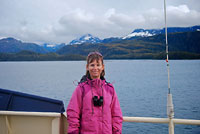

 | |||||||||||||||||||
|
|
Journals 2008/2009Karen Rudio
September 17, 2008 The first thing I did this morning was to photograph the beautiful sunrise. It was awesome seeing the sun again after seven days of rain. Overnight, we have traveled to within sight of the mountains of the Kenai Peninsula. They are snow capped, covered in evergreens and beautiful. Just before entering Prince William Sound, we crossed what looked like a river of water. It was part of the Alaska Coastal Current. This current is formed from river and glacial runoff and is fresher and less dense than the surrounding seawater. It flows North along British Columbia through Prince William Sound and out into the Gulf of Alaska.
Inside the Sound the water was like glass. We saw three kinds of ducks---Harlequin Ducks, Common Mergansers and White-winged Scoters, plus cormorants, gulls, two types of huge jellyfish, but the best were the several sea otters. Brad informed me that when Alaska was purchased from Russia, the sea otters were hunted almost to extinction. They have made a nice come back and are a lot of fun to watch. They float on their backs and pound open shellfish using a rock.
Last night, Ken and the students completed their stations with the multi-net. The lost sparrow took a fancy to Allison's wool hat and perched there for quite a while.
I shot quite a bit of video today. First the ship's engineer Eric Nelson took David Leech, the research engineer, and me on a tour of the engine room. I was very impressed by how clean it was. I learned that the ship makes its own fresh water by desalination. Eric explained the process on video to my students. The ship has two large generators and two even larger engines and two ten foot long rudders that make the ship exceptionally maneuverable.
Next I shot Russ explaining the history behind this expedition and its objectives. He explained how each piece of equipment is used and what types of data are being collected. Then he brought up some beautiful pictures on his lap top of various types of zooplankton. He was very comfortable behind a camera and his explanations were on a level my students will be able to understand. I hope they will appreciate how unusual it is to have a scientist of Russ's caliber taking time to teach them. In fact, Russ usually only teaches at the graduate level.
Since this was the first nice day in quite awhile, many of us spent time out on the bird deck. We were hoping to spot some Orca (Killer Whales), but no such luck. I enjoyed chatted with Allison about her Peace Corps experience in Bolivia. Jeannette described her first winter in Fairbanks and how she learned all the different kinds of snow. Meanwhile the most beautiful scenery was going past both sides of the ship.
We completed three stations in Prince William Sound this afternoon called KIP (Knight Island Passage), PWS 1 and 2 (Prince William Sound). Water samples and preserved zooplankton samples were collected at all three, but KIP is the last station where live zooplankton are collected. Russ set up his last copepod egg experiment of the cruise. This evening Ken is deploying the multi-net at KIP, MS (Montague Straight) and HB 1, 2, 3, 4 (Hogan Bay). |
||||||||||||||||||





